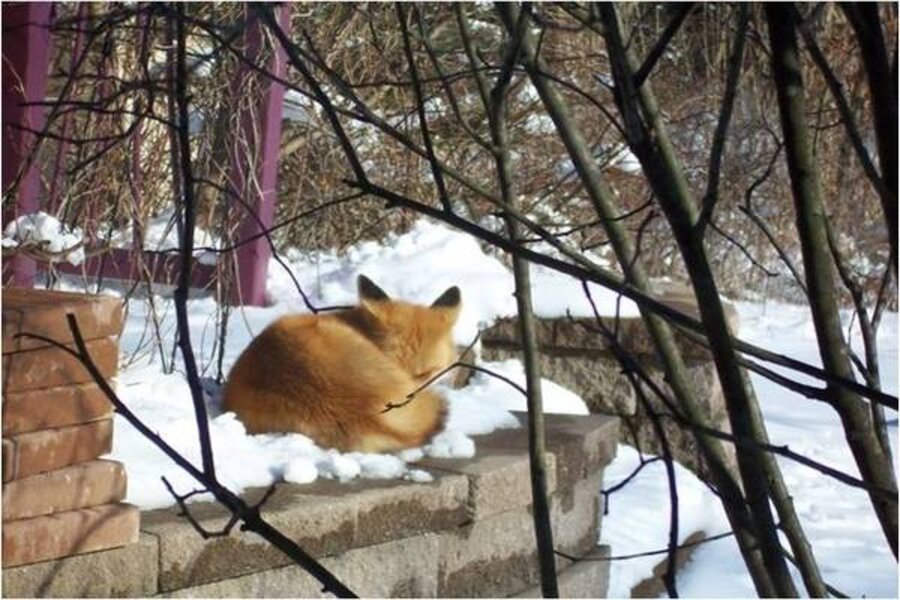Gardening for the birds and wildlife
Loading...
As large, slow-moving snowflakes drifted down on New Year’s Day, a male red fox trotted down the steps past my garage and made his way to the patio. The surrounding border of perennials was covered with nearly a half foot of snow, and the ornamental grasses were bending in the wind.
This fox, on a mission for a meal, proceeded to tilt his head towards the perennials, as if listening to the dried, rustling coneflowers. Several times he stuck his snout deep into the drifts of snow, but came up empty.
After marking his territory on several bushes and the mailbox, he made his way back into the woods. My New Year’s wish is that he comes back often this year to take care of the mice and meadow voles that have been dining on my tulip and grape hyacinth bulbs.
Winter forces gardeners to take a break from all the things that preoccupy us during the growing season — planting, pruning, weeding, fertilizing, watering, cajoling and cursing our plants.
February is a great time to pull up a chair and observe what’s taking place in and around your garden. And one of the best spots for action is the bird feeder.
Our feeder hangs outside the kitchen window and is a daily magnet for a flock of American tree sparrows, as well as a few chickadees, slate-colored juncos, two types of nuthatches, a lone goldfinch, two squirrels that think they are birds, and two female cardinals.
Before West Nile virus arrived in Illinois, the woods nearby were home to the tufted titmouse, a shy bird that looks like a miniature gray cardinal. This unfortunate disease has decimated the local titmouse population as well as other bird species, but we hope that they will make a comeback as some of the surviving birds build up resistance to the virus. Providing fresh seed and keeping feeders clean is said to be key to protecting birds from other diseases and illness caused by rotting, moldy seed.
Creating a bird-friendly habitat
Whether you live in a busy town, a suburb, or a rural area, there is much that you can do in your garden to help our feathered friends by planting trees, shrubs and perennials that provide them with food and nesting habitat. Even a small bird-friendly habitat can help offset somewhat the natural areas that are lost to development every year.
Some trees and shrubs that provide berries or seeds for birds include serviceberry (Amelanchier), viburnums, beeches, chokecherries and chokeberries, elderberry, staghorn sumac (Rhus), red osier dogwood, winterberry holly, Northern bayberry, quince, shrub roses, hazelnuts, cotoneaster, pines, hawthorn trees and mountain ash. A shrub border that is planted thick and dense offers cover, a place for birds to rest or nest, away from predators.
You can learn more about birds, how to attract them, and what to use in your feeders at Cornell University’s ornithology (bird study) website.
Another good resource is the Illinois Audubon Society, which has been working since 1897 to protect Illinois birds, wildlife, and habitats. In recent years, the Society purchased more than $2 million worth of land, mostly needed by threatened and endangered species. You can join the Illinois Audubon Society and receive its quarterly magazine and newsletter for $25 a year for an individual or $30 for a family. For more information, visit the website.
Editor's note: You may also be interested in these articles at Diggin' It about attracting birds to your garden with native plants:
These native plants attract birds to your winter garden
How to choose trees that will encourage birds to hang around your yard
A bird-friendly garden needs good shrubs
Annuals and perennials that attract birds to your yard
A year to celebrate rudbeckia and eggplant
The National Garden Bureau recently announced that 2008 is the Year of Rudbeckia and Eggplant. Rudbeckia (black-eyed Susans) are perennials that attract butterflies and other pollinators. They make great cut flowers and are very easy to start from seed. If the only eggplant you’ve tried is the giant, tough-skinned purple variety from the local produce section, you’re in for a pleasant surprise. Many tender, long and narrow Asian varieties—some pure white or tinged with purple and white—can be grown from seed in pots or in the ground. For more information on selecting and growing rudbeckias and eggplants, visit the National Garden Bureau and click on “gardening.”
-----
Nina Koziol gardens on a deer-infested acre southwest of Chicago where her beds and borders are designed for butterflies, hummingbirds and other wildlife. She teaches classes at the Chicago Botanic Garden. Find out more on her website, This Garden Cooks.





